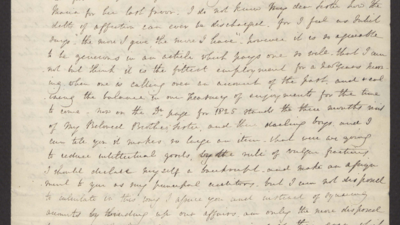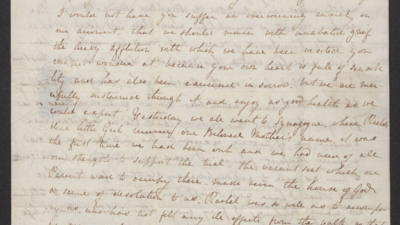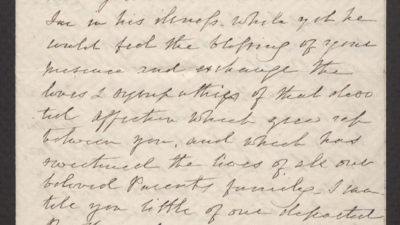Oral History Interview with Helene Goodman
Title
Date
Contributor
Summary
Helene Goodman, formerly Henia Flint, was born in Lodz, Poland in 1913 into an orthodox family. She studied piano at the Warsaw Conservatory posing as a non-Jew, and got her diploma in 1935. She briefly describes how the German invasion affected Polish Jews. In 1939 Helene and her family had to move to the Lodz Ghetto. Her father was brutally beaten by the KRIPO (Kriminalpolizei), lost his mind, and later died. She witnessed Polish-German cooperation, and the murder of Jewish orphans in the ghetto.
Helene and her mother were transported to Auschwitz in August 1944, when the ghetto was liquidated. She describes the dehumanizing arrival process. During a “selection” by Dr. Mengele, she was separated from her mother and never saw her again. She is the lone survivor of her family. Helene was forced to play the piano for the camp commander’s birthday party and was stabbed repeatedly when she was too stunned to perform. Her wounds were not treated. A Jewish KAPO put her on a transport to Hainichen (a subcamp of Flossenbürg), near Chemnitz, Germany to save her life.
Helene worked as a slave laborer at Framowerke, an ammunition factory. She describes living and working conditions. The supervisor was Gertrude Becker, an SS woman who was extremely cruel. She describes the effects of near starvation, how she tried to cope, and her acts of sabotage.
Helene describes a Deathmarch at the end of April 1945, guarded by SS officers who took off their uniforms and fled once they arrived at Theresienstadt. She was liberated by the Soviet army May 9, 1945. Soviet women doctors treated the survivors. American soldiers took her to a quarantine camp at Landsberg am Lech where she tried to recover from the physical and emotional after effects of her experiences. She describes her post-war life in Regensburg, Germany after she met and married her husband, Jacob Gottlieb, including a frightening act of antisemitism and Zionist activities.. They lived in Regensburg, Germany until they immigrated to the United States. She concludes with her personal reflections on the Holocaust.
More Sources Like This
of
Alan Spiegel
Alan Spiegel was born August 11, 1903 in Orahovicza, Yugoslavia into a wealthy Zionist family. He details his family history in Hungary including his grandfather being a Second Adjutant during the Hungarian Revolution. Mr. Spiegel studied medicine at Budapest University. He discusses the difficulty for Jewish students to be admitted due tonumerus clausus policy and that he was dismissed in 1920, three months before graduation by a prejudiced faculty. An ardent Zionist, he then worked for the Jewish National Fund while employed in a family business.
In 1932, he married Elizabeth Boschan, in Cluj, Romania, where they lived until 1939. In Budapest, he had to serve as a slave laborer under the Hungarians. Mr. Spiegel gives testimony about working with Rezsö Kastner and Joel Brand to exchangethe release of over 1,000 Jews to Switzerland for money in 1944 and how he found out from one of the more humane German officers that their transport was destined for Auschwitz even though they paid. He details how he arranged to bribe other SS to have the transport sent to Bergen-Belsen instead. Two months later, a smaller group of 350 was sent to Switzerland of which he and his family were a part. He discusses how Kastner was condemned in Palestine for his actions. Mr. Spiegel also shares a vignette about how he secured the release of hundreds of Jewish boys and how small meaningful occurrences helped him have the strength to continue his work. He also relates memories about theVizhnitzerRebbe.
In 1947, Spiegel emigrated from Switzerland to the United States with his wife and daughter.
of
Raoul Harmelin
Raoul Harmelin, the only son of a doctor, born September 11, 1924 in Boryslaw, Poland, received both a secular and a Jewish education. He talks about pre-war life in Boryslaw-- whose main industry was oil refineries-- and life under German and Russian occupations. Raoul describes life under the Germans after June, 1941, including pogroms, anti-Jewish measures, attitude of the local population, and formation of forced labor battallions organized by the Judenrat. He describes a series of Aktions (roundups and mass murders of Jews) from November 1941 to 1943, and the murder of 600 Jews in Doly in great detail. Some were conducted by a German VernichtungKommando under General Katzman. Polish and Ukrainian locals, Austrians in the Schutz Polizei and Reiterzugpolizei, the Polish Kriminalpolizei , and Jews in the Ordnungsdienst all helped to round up Jews. Jews were sent to a camp at Ulica Janowska in Lwow or to forced labor in local industry, most were transported to and murdered in Belzec. Raoul escaped from a roundup where he witnessed the murder of an infant and a young girl.
His father continued to work because Jewish doctors were needed to treat the citizens of Boryslaw. One of his patients hid Raoul and his mother. A ghetto was established but was liquidated after a forced labor camp for Jews was opened in 1943. Jews who could not hide were eliminated or worked as slave laborers in the Zwangsarbeitslager in Boryslaw. Raoul and other Jews who worked in connection with the war effort had some degree of protection. He got news from London via radio and from an underground paper published by ArmiaKrajowa (Home Army). A Ukrainian acquaintance hid 13 Jews, including Raoul and his parents from March 13, 1944 to August 8, 1944, when the Russians came back.
He describes postwar life under Russian occupation, including two arrests and escape to Breslaw. He and his parents decided to leave Poland after a pogrom in Kielce. After a stay in Paris, aided by HIAS, they arrived in Sidney, Australia in November 1947. He was able to bring his new wife and her parents to Australia later. He talks about his life in and adjustment to Australia after a very difficult beginning. He closes by naming relatives on both sides of his family who were killed or survived, and reflects on the actions of non-Jews during the Holocaust. See also 2 interviews with his wife, Rita Harmelin.
Note: Collateral Material available through the Gratz College Tuttleman Library are photocopies of these German documents:
Certificate for Raoul
Harmelin
that he can walk in the street unaccompanied by an Aryan.
The same document for his father, Dr. Elkan
Harmelin
.
Work I.D. Card for Raoul
Harmelin
.
I.D. Card for Regina
Harmelin
, his mother.
Tags with letter "R" which indicated that Raoul
Harmelin
and his parents were assigned to a work detail.
of
Herbert Broh
Herbert Broh was born in Berlin, Germany in 1930. He shares his childhood memories of his life in Germany and his family’s journey to Shanghai. Herbert relates several experiences of abusive antisemitism by his friends and his teacher, as well as his impressions of Kristallnacht.
His family left Germany for Shanghai in April of 1939 to join family members already living on Seward Road in the Hongkew section of Shanghai, under Japanese occupation. Herbert was enrolled in the Kadoorie School and later a cheder. He talks about his Jewish education at the cheder and the Yeshiva Katana in great detail, as well as the effect of his growing orthodoxy on his life and his family. He describes his family’s living conditions and life in Shanghai and states he was very happy there. He was only dimly aware that other refugees had a more difficult existence. His father worked for a Chinese factory managed by Japanese; his mother worked as a cook at the Komor Kindergarten.
After Pearl Harbor, his family was evacuated to the Kadoorie School. He mentions interaction between Japanese and refugees. He vividly describes the events during and after the Japanese capitulation and the arrival of Chinese Nationalist and later American troops. He witnessed the departure of the entire Mirrer Yeshiva to Canada in 1946. Herbert and his family went to the United States in 1947. He describes his life in the United States and his feelings about his years in Shanghai. He is now a Cantor in Sun City, California.
Interviewee: BROH, Herbert Date: October 15, 1999


